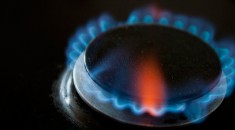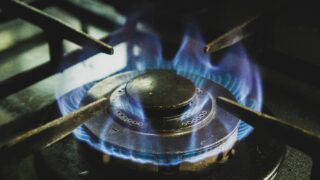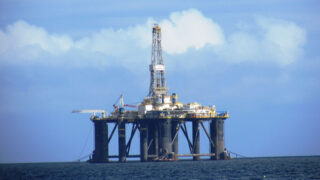Peter Read may have one of the most unusual jobs of any UNISON member. Peter is a jetty engineer for National Grid at its Isle of Grain terminal on the Thames Estuary, the UK’s leading importation terminal for liquefied natural gas (LNG).
This frozen gas is transported in special ships from all over the world. When a ship docks at Grain, the LNG is pumped into the site’s vast tanks, where it is stored until needed. The process of pumping the gas from the ship, through 1.5 miles of pipe to the site’s tanks is complex and hazardous. Peter is responsible for that process, with the safety of colleagues and a state-of-the-art facility worth millions in his hands.
We look after the LNG for the UK’s gas providers. Three of our storage tanks are the size of the Royal Albert Hall. That’s a lot of gas, and when we’re operating at full strength we can supply 20% of the gas that the whole country needs at a given time. It only dawns on me when I’m speaking to other people what an important job I’m doing. And most of the staff here are UNISON members – the operations team, admin staff, the contract and maintenance teams, some of the managers, from top specialist roles to electricians and mechanics.
Some of the North Sea oilfields have got a bit more life in them, but we’re increasingly dependent on oil from farther afield. Before gas is transported it’s frozen to -160° C and liquefied. The biggest ships contain 260,000 tonnes of LNG, but when it’s returned to gas form you can multiply the quantity by 600.
We have seven people on the team. The site engineer is in charge of the whole site. The jetty engineer is his right hand man, responsible for when the ships come in. And there are five operators, for instruments, electrical, mechanical.

I’ve been at Grain for nine years. I started as an instrument technician, and became jetty engineer five years ago. My primary function is to offload the ships – to look after them when they come in, get them running, make sure everything is safe while they are discharging the gas, everything to do with the ship from when it arrives to when it goes out again.
I have to ensure there are no nervous breakdowns, because if you don’t know what you’re doing it can get messy. This is one of the most hazardous operations on the site.
The gas is mostly methane. LNG is very stable when it’s contained, but the instant it hits the air it turns to gas – and this is when it becomes flammable. With the temperature change it’s as if it’s alive, and a little leak becomes a big gas cloud very quickly. What’s dangerous is the gas-air mix, and this is what I must ensure never happens.
When the ship is on the berth my first job is to go on board and have a meeting with the captain and chief officer. There are lots of safety questions, a lot of paperwork, and I have a safety walk around the ship while my operators are getting ready with the hydraulic arms that will enable the pumping of the gas ashore.

Once the arms are ready to go, we start discharging. It starts slowly, eventually reaching 2,000 cubic m/hour, for more than a day.
We have various safety features. If one of the arms came off and LNG hit the ship the freezing cold would fracture the steel and the ship could break apart. So a water curtain pours over the side of the ship throughout the operation, so that the cold water can dissipate any gas. It also makes a nice water feature!
We have water pumps in case of fire, which would be Armageddon in this environment. There are fire and gas detectors everywhere. We all have fire training and we all wear protective clothing. There is a fibre optic communications system, which connects the ship with our control system. It’s very tidal here. If the ship moves too far out of position this system will kick in and shut everything down. And if it’s a serious shift the arms are automatically disconnected, to stop them from ripping off or pulling the whole jetty into the river and spilling LNG.

At the end of the discharge my operators need to ensure that all the methane is drained out of the arms. If there is gas left in there and it came in contact with air, it would go off like a cannon. Meanwhile, I have another meeting with the captain, to discuss how much has been discharged and the quality. Again, there’s a lot of paperwork. And the ship is ready to go.
As well as the interaction with the captain at the beginning and the end, every four hours I go on board and make a safety walk of the ship with the chief. And I can go on board any time I want if I’m unhappy with something.
You always have to remember what you’re dealing with. Generally speaking, because of our safety system there’s rarely a problem, and even then we know how to deal with it.
I’ve also been a safety rep here for six or seven years. I was asked because of the experience I had of working offshore, in power stations, nuclear and chemical plants.
Staff have safety meetings once a month, after which I and the other reps will take up any concerns with management. If it’s about safety they’re always with you, not against you. Also, a lot of the managers know my background, so if I bring something up they take it seriously. They know I’m not talking paper cuts. There is a potential for someone to get hurt.

Mine is quite a specialised job – there aren’t hundreds of jetty engineers in the country. And it’s probably the most diverse role on the site. I get to meet different ships coming from all over the world. I also work in the permit office, meeting different people there. And the shift team is a bit like a family.
I live nearby, in Gillingham, and I was very fortunate when the Grain site was being converted to an energy terminal right on my doorstep. I’d been wanting something more permanent and got this opportunity. My street points straight as a die towards our jetties. If I know a ship is due in I can go up to my loft and see her coming. It’s quite a special feeling.
This article first appeared in U Digital in May 2015





